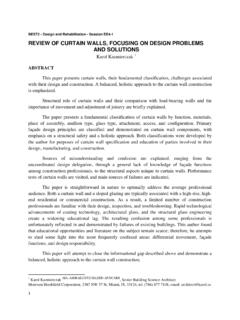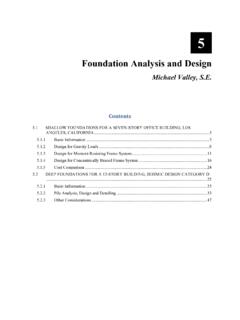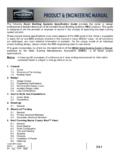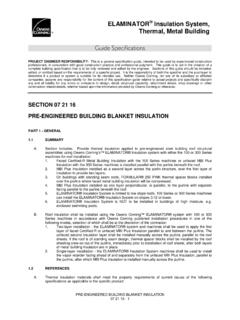Transcription of How to Estimate the Cost of Interior Building Finishes ...
1 1 How to Estimate the Cost of Interior Building Finishes from Schematic Drawings CPE Candidate No. 0714108 December 2014 2 How to Estimate the Cost of Interior Building Finishes from Schematic Drawings Table of Contents Section 1 Introduction page 3 Section 2 Types of Methods of Measurements page 5 Section 3 Project Specific Factors to Consider in Takeoff and Pricing page 7 Section 4 Overview of Labor, Material, Equipment, Indirect Costs and Approach to Markups page 9 Section 5 Special Risk Considerations page 10 Section 6 Ratios and Analysis Testing the Bid page 12 Section 7 Other Pertinent Information page 13 Section 8 Sample Sketches page 14 Section 9 Sample Estimate Takeoff and Pricing Sheets page 16 Section 10 Glossary page 18 Section 11 References page 19 3 Section 1 Introduction This technical paper is intended to provide the reader with a general understanding of performing professional construction estimating services as they relate to Interior Building Finishes from Schematic Drawings.
2 Schematic Drawings are the first set of measured drawings in the design process. Typically Schematic Drawings have very limited, if any, documentation of Interior Finishes . Schematic Drawings primarily focus on having the right type and size of spaces. They do not include a Room Finish Schedule or specifications. The detailed information on Interior Finishes is usually included with the next phase of the design process in the Design Development documents. Sometimes the designer may provide a Design Narrative with the Schematic Drawings with some general information on the types of Interior Finishes . A construction estimator must understand the client s standard level of Finishes and the standard level of Finishes of comparable spaces.
3 Main CSI (Construction Specifications Institute 2004 MasterFormat) Division Division 09 Finishes Main CSI (Construction Specifications Institute 2004 MasterFormat) Subdivisions 09 20 00 Plaster and Gypsum Board 09 30 00 Tiling 09 50 00 Ceilings 09 60 00 Floorings 09 70 00 Wall Finishes 09 80 00 Acoustical Treatment 09 90 00 Painting and Coatings 4 Brief Description The author will discuss the requirements of the Construction Estimator to review the Schematic plans and any other available information, to develop an Estimate for Interior Finishes . This paper will be presented generally from the point of view of a Construction Manager in the Midwest Region of the United States. The goal of the schematic Estimate is to provide the client and/or designer the necessary information to make the decision to continue through the Design Development Phase of the project.
4 It is relatively easy to make changes in the design at this early stage of a project. A sample set of drawings and cost Estimate is also provided in sections 8 and 9 for reference. 5 Section 2 Types of Methods of Measurements Quantity take-offs for Interior Finishes measure all the visible surfaces within a Building . This includes the ceiling, flooring and walls. Each space or room within a Building should be independently taken-off. A simple matrix similar to a Room Finish Schedule should be developed. This may require more upfront work to create this tool, however it is often helpful in case an assumption of a space is incorrect or changes are requested. The room matrix can be easily adjusted without having to perform more take-offs.
5 Ceilings and Flooring are measured by the horizontal square footage (SQ FT). Wall Base is measured by the perimeter of the space, or lineal footage (LN FT). Wall tile, wall treatment and painting are measured by the vertical square footage (SQ FT). There are some unique items that may be counted (EACH) or carried as an allowance (ALLO) at this point in the estimating process. For spaces that are square or rectangular, it is simple to calculate the area by multiplying the width by the length. Often there are irregular spaces that require more complex geometry calculations, especially spaces that have angular or curved walls. When measuring irregular spaces, an estimator should measure slightly beyond the room, especially at cut outs to account for waste and slower production rates at these areas.
6 There are several take-off software programs out in the market and within the industry that can assist in calculating these types of spaces. If the ceiling and flooring are measured on the same floor plan, use a hatch pattern for one of the two items and a solid color for the other to help distinguish them from each other. In addition to taking off the floor and ceiling area of a space, the perimeter of the room should also be calculated. This will be used for not only the wall base, but also to help Estimate other wall surfaces. The height of the space also needs to be calculated. Often the height of a space is not available on the Schematic Drawings. In this case a standard wall height of 10 per story can be assumed.
7 For the wall 6 area, it may be necessary to adjust if there is glazing, casework or other furnishings on the wall. For items like doors, frames, exposed metal or other single items, these should be individually counted for painting during the estimating process. An allowance is often used at this phase of the design process. This may be for special drop soffits that may become part of the design, or possibly for an accent wall or other wall graphics not yet designed. 7 Section 3 Project Specific Factors to Consider in Takeoff and Pricing There are some specific factors to consider when pricing Interior Finishes at any phase of the design documents. The quantity, location and weather all have an impact on the cost of Interior Finishes .
8 Consideration of all three of these factors is important during this phase of the estimating process. Small Quantities vs. Large Quantities The general rule of thumb that there are cost savings for larger volume applies to Interior Finishes . When there are large spaces or several similar spaces, the labor productivity for installation increases and the amount of material waste decreases. Furthermore, manufacturers often provide discounted pricing for high volume of materials. For smaller spaces, the finish work is generally more tedious. There are more cut outs and this is much more labor intensive. Also, there are some fixed pricing items on projects, such as equipment, that proportionally burdens smaller projects more verse being spread out over a larger project.
9 Geographic Location The location of the project within the United States generally has an effect on the cost of Interior Finishes . The labor rates will vary from area to area. It is important to take into consideration, demographics during the estimating process. A highly populated area such as New York or California, for example, will have higher labor rates due to the higher cost of living versus a more rural area. There may also be a transportation factor depending on the location of project. A project in a more rural area may require materials to be shipped a much longer distance. Remote projects may also require workers to stay in temporary lodging. Seasonal effect on work Most Interior finish work can only be installed once a project is reasonably weather enclosed.
10 High levels 8 of moisture and low temperatures restrict the installation of Finishes . In some warmer areas of the country, the weather is not as much of a factor for construction. However in the Northern part of the Country, the schedule for the Interior Finishes is much more restricted during the winter season. In these parts of the Country, there may be a higher cost to complete the work in the Spring/Summer when there is a high demand to complete as much work as possible during the peak construction season. The cost to install Finishes may be lower during the winter season when contractors are looking to keep their employees steadily working through down seasons, however, this can easily be offset on the overall construction budget with the cost of temporary enclosures and heat.



















